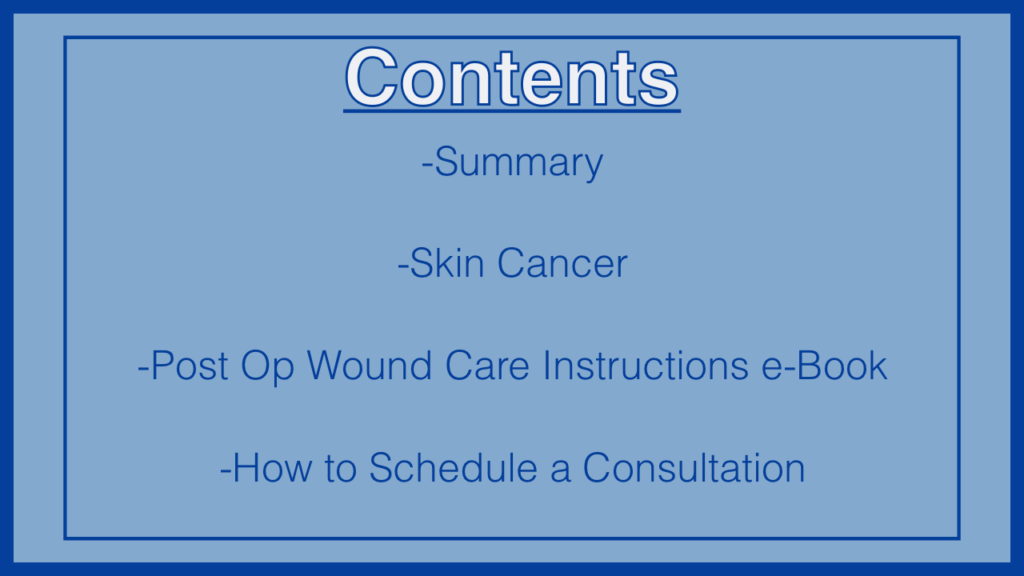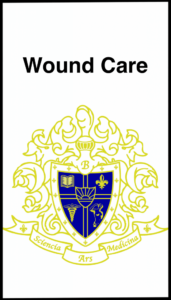
.
Summary
Skin lesions can be removed by a special “shave excision” technique. The shave excision technique is utilized if the skin lesion is in the top portion of the dermal skin layer. In this case, special instrumentation can be used to remove the lesion. It is then sent to the pathologist for evaluation. Hydrogen peroxide and Bacitracin are applied to the area 3 to 4 times a day for the first week following surgery. Within several days a new layer of skin resurfaces the area. To the naked eye, the area will appear smooth. However, if we used a magnifying glass, there would be a slight depression. This gradually fills in over several weeks to months. It is my experience that 80% of the time the areas will heal to the point that the area is undetectable or there is only a slight blemish. Approximately 20% of the time the lesion will extend into the deeper layers of the skin and will recur or the area will not heal as desired and will need additional treatment. In that ease, a traditional skin excision is usually required. When an excision is performed and stitches are required, the skin will always heal with some degree of scarring. For that reason, we prefer to use a shave excision technique if at all possible.
Skin Cancer
It is not uncommon for the biopsy done by the original doctor to have completely excised a more superficial skin cancer. When a biopsy is taken, the doctor will then cauterize the base to seal up the blood vessels. There is usually scabbing and crusting as part of the healing process. This can “kill” the remaining skin cancer cells that are at the margin if it is a “superficial” skin cancer. In these cases we can simply do a “microscopic shave re-excision” of the area. We have the patient clean the area with hydrogen peroxide and apply bacitracin 4-6 times a day until the area heals. Usually the area will heal with minimal or no scarring. If the second biopsy comes back as negative, we simply observe the area. If the lesion would recur, we would then excise the area more deeply which would require closure with sutures. In most cases no lesion reoccurs and the patient is cured.
In other cases we need to excise more deeply to insure the skin cancer has been removed. In these instances we have three options.
Option #1
Option #1 is to excise around the skin cancer, taking a small “cuff” [3-4 mm] of normal tissue to be sure the skin cancer has been completely removed. The wound is then closed in multiple layers and a tape dressing is usually applied. The excised specimen is sent to the pathologist to be examined to be sure the “margins” are clear. It takes approximately one week to process the specimen and for us to receive the report. We see the patient back at one week to examine the area and to review the path report. If the report shows that the margins were “negative” and all the skin cancer was removed, no other treatment is needed other than annual exams. However, if the margins are “positive”, the entire area must be re-excised and the process repeated. The advantage to this option as that it can be done at the initial visit and is less expensive. The disadvantage is that additional excision may be necessary.
Option #2
Option #2 is to excise the skin cancer with a “cuff” of normal tissue as in Option #1, but to have the margins microscopically examined by the pathologist at the time of surgery. This is what is commonly called a “frozen section”. The pathologist takes the excised tissue, freezes it in a special process and then examines it under a microscope to determine if the “margins are free” and all the skin cancer has been removed. If not, the process is repeated until the entire tumor has been removed. At this point we would close the excision in multiple layers and apply a tape dressing. The post-operative care is the same as with Option #1. The advantage to this option is that you know the area has been completely removed at the time of surgery. In cases where the skin cancer is large and a significant amount of tissue must be removed, simply “pulling the skin edges together” will not work, and a skin flap or skin graft is necessary. In such cases it would be difficult to re-excise the area if the margins were positive, so we would want to do everything possible to be sure the skin cancer was completely removed at the time of this more complex reconstruction. The disadvantage to Option 2 is that it is more time consuming, usually needs to be done as an outpatient in the hospital, and is much more expensive.
Option #3
Option #3 is to have what is called Mohs microsurgery. This is done by a dermatologist who has special training in this technique. They microscopically excise the skin cancer to be sure the tumor is completely excised, but do it in such a way as to minimize the amount of normal tissue that is removed. This technique is especially useful when the skin cancer is near vital structures such as the eye or nose, for removal of certain types of more aggressive skin cancers, and for skin cancers that have recurred. The advantage to this option is that it insures the cancer has been completely removed and preserved as much normal tissue as possible. The disadvantage to Mohs surgery is that it is a much more time consuming process, need you return to us for reconstruction after the Mohs surgery, and it is the most expensive option. For follow-up care you would see both us and the Mohs surgeon.
“Postoperative care for Options #1-3“
– Sleep with head elevated 30° for two weeks
– No heavy lifting or straining over 5 pounds for 1–2 weeks
– Apply ice compresses were ice pack the area for 24-36 hours to minimize swelling and bruising
– Keep tape in place until comes off myself/then clean area with hydrogen peroxide and apply bacitracin ointment 4-6 times a day
– Take temperature twice daily and call doctor if temperature is over 100.6 F.
– Call doctor if there is increased pain, swelling, or drainage
“Follow Up Care”
Patients are usually seen the day following the procedure and then at one week. At the one-week visit the tape dressing is gently removed. At that time the doctor will remove any remaining sutures. Dissolvable sutures are usually used. In some cases a more permanent suture may remain for one to two weeks which is gently removed by the doctor at that time. Depending on the healing process, tape may be reapplied or the patient may be placed on the moist dressing wound care of cleaning with hydrogen peroxide and applying bacitracin ointment 4-6 times a day. A topical steroid cream is often prescribed to apply on the incisions at night for three weeks to help decrease redness and to minimize scar formation. The patient is seen for follow-up at several months intervals to monitor for optimal wound healing and the possibility of any recurrence of the skin cancer. For patients who have had skin cancer, it is important to take increased measures to help minimize sun exposure such as avoiding excessive sun exposure, wearing sunglasses, using a sunscreen with an SPF 30 or greater. It is important for patients to be alert for any signs of skin cancer and report to the doctor immediately if they note areas that are increasing in size; changing in color; changing in shape; are painful; bleeding; or frequently irritated.
“Insurance”
Skin cancer excision and reconstruction is not cosmetic surgery and is covered under most insurance policies. In most cases there is a charge from the surgeon, a facility fee, a fee from the pathology lab, and a separate charge from the Mohs doctor if that procedure is performed. Insurance policies very significantly individual policies may have specific requirements regarding what type of procedures is covered, by whom, and when. It is important for each patient to review their individual policy to ensure that they are complying with all the requirements and obligations they have agreed to this part of their insurance coverage. While we are happy to assist patients with their insurance, health insurance is a contract exclusively between the patient and the insurance company they have selected, not the doctor. Ultimately each individual patient is financially responsible for their care and ensuring that information is been properly and timely submitted to their insurance company and that they have complied with all their insurance company requirements. Medicare requires that patients go to a Medicare participating physician if they desire to have Medicare cover that doctor’s services. We do not participate in Medicare, so our services cannot be turned into Medicare for coverage.
“Post Op Wound Care Instructions”
.

.
Schedule A Consultation Now!
Communication is not secure. Contacting the practice does not establish a physician/ patient relationship.*
.
For more information on procedures and wellness, visit our collection of free, downloadable eBooks
.
Follow us on Facebook for weekly tips on health and wellness.
.